10 Tricks to Combat Muscle Soreness
Dear Lisa,
Love your blog! I’m just getting back to strength training and OMG do I hurt! Is there anything I can do? -Nikki
Dear Nikki,
Thanks for reading my blog and congrats for getting your fitness on! Whether you’re just getting back into the gym or you’re trying to push past a plateau and are lifting heavier, at some point you are going to experience muscle soreness. I used to take ibuprofen after a tough workout, and while it did remove the symptoms of pain, it didn’t really aid in muscle recovery, which, as a bodybuilder, is something desired. Why work so hard if not for muscle gains right?

First, let’s talk about why you’re sore. Each time you are lifting weights you actually are tearing your muscle fibers, breaking them down. But your gains don’t really start until the moment you put down the weights, during what’s known as your recovery time. This is when your body works to repair those torn muscles, building them back stronger and larger than they were before. For this reason, what you do to recover is just as important as how heavy you lift.
One of the ugliest parts of bodybuilding is a little thing called DOMS, which stands for delayed onset muscle soreness. The first time I experienced this was after a leg day workout. It didn’t seem so bad at the time. I barely lifted my own body weight and I thought my trainer was going easy on me. The next day I could barely get out of bed and the thought of climbing the stairs made me cry. So did sitting, standing and walking. Any gym rat will tell you that leg workouts hurt more than any other muscle groups because they are the largest group of muscles in the body. 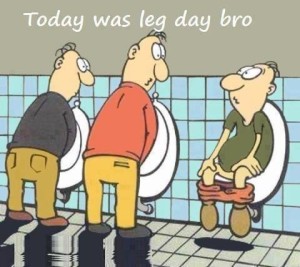
While your body works to repair the muscle tears, you may experience inflammation (like an intense heat) and lactic acid build up (think leg cramps in the middle of the night) both of which cause stiffness and pain. Please keep in mind that I’m not a doctor and don’t play one on the internet, so this is for information only, and you should consult a doctor if you want medical advice. That said, here are some techniques I’ve personally used to both reduce pain and promote muscle recovery.
10 Ways to Combat Muscle Soreness
- Eat away your pain. No not with a cupcake. If you have lactic acid build up (runners get this a lot) you will want to flush that out of your system.
 Drinking at least 8 glasses of water per day helps with this. When I’m training hard I drink at least a gallon a day. Ever wonder why rest stations at marathon races have bananas? It’s because another way to get that lactic acid out of your body is to increase your potassium intake.
Drinking at least 8 glasses of water per day helps with this. When I’m training hard I drink at least a gallon a day. Ever wonder why rest stations at marathon races have bananas? It’s because another way to get that lactic acid out of your body is to increase your potassium intake. - Supplements. BCAA (which stands for branch chain amino acid) and Aminos supplements come in powder and pill forms and help patch those torn muscle fibers back together.
 Think of them like supplement band-aids. The sooner your muscles are repaired the better you will feel.
Think of them like supplement band-aids. The sooner your muscles are repaired the better you will feel. - Ice bath. Okay, I’m not going to lie here, ice baths suck. The first time my trainer told me to take an ice bath I said ok and then took ibuprofen instead because the thought of it was too scary for me.
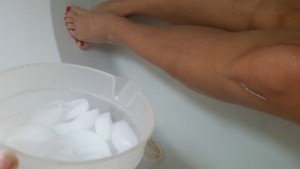
Wait for it…. But after a particularly grueling leg workout I finally broke down and took an ice bath and it really helped reduce the swelling and inflammation. Here are the steps: 1 – Fill your bath part way with lukewarm water, because if you put cold water in there you’ll never get in. 2 – Get in the tub. 3 – Take pitchers of ice from your freezer, or a bag or two of ice from the grocery store, and dump it in the tub, over your legs. 4 – Scream loudly/whine while you stay in the ice bath for at least 20 minutes.

Feel free to scream…now Tips: A – Since ice baths are freezing and I’m only really doing it for my legs, I usually keep the water level low and wear a sweatshirt to keep my upper half from shivering. B – To distract myself from the discomfort of the coldness, I use this time for reading magazines or playing on my smart phone that I keep on a towel next to the tub.
- Epsom salt bath. Immediately after the above mentioned ice bath, I take a hot Epsom salt bath. The primary ingredient in Epsom salt is magnesium, which is a mineral that can be absorbed through the skin and helps to relax the muscles by flushing out the lactic acid.
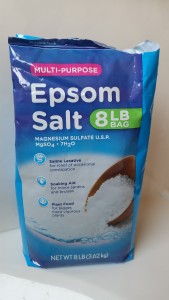 Mix 2 cups per gallon of water and soak. Warning: according to the label on the Epsom salt bag, do not use this if you are a diabetic, due to the role magnesium plays in insulin resistance.
Mix 2 cups per gallon of water and soak. Warning: according to the label on the Epsom salt bag, do not use this if you are a diabetic, due to the role magnesium plays in insulin resistance. - ICYHot/Bengay. The active ingredients in these products are menthol, which has anesthetic qualities and feels icy when it goes on, and methyl salicylate, which causes your capillaries to dilate and blood to flow in the areas where the cream is rubbed in, making your skin feel hot.
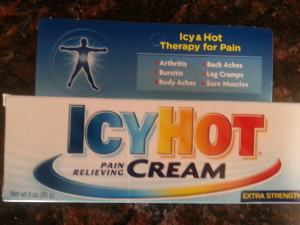 They are effective at relieving pain, but they are kind of stinky, or as my kids say, “You smell like an old person, Mommy.”
They are effective at relieving pain, but they are kind of stinky, or as my kids say, “You smell like an old person, Mommy.” - Foam Roller/Massage Balls. Ever wonder what a knot is? Your muscle fibers are supposed to all go in the same direction, but when you get a knot your muscle fibers are stuck in the contraction mode.
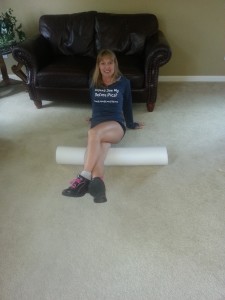
Self myofascial release When you press your entire bodyweight against the foam roller or massage ball on the most tender spot (the knot) and hold that pressure there for 30-60 seconds the golgi tendon organ (GTO) will signal your muscle fibers to relax. I’m convinced these products are derived from medieval torture devices, but if you can make it past the required 30-60 seconds of intense pain, you will feel better.
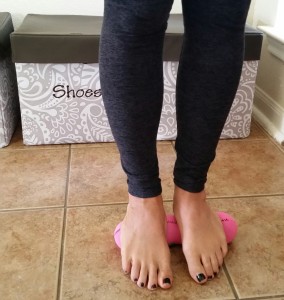
Foot massage – yes! #theorigianlworm massage balls Runners in particular will want to roll out the outside of their thigh where the IT band stretches from the hip to the knee and can get very tight from all the miles logged running.
- Stretching. Once a week I take a pole dance class that begins with an hour of just stretching. I start the class with my muscles very tight and sore but by the end of class much of my pain is mitigated and I have more flexibility back.
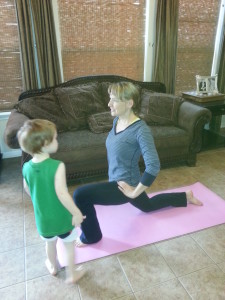
Runner’s Stretch lunge with Little Henry Whether you do yoga, Zumba, Pilates or runners stretches, they help to elongate those contracted muscles plus they are fun.
- Shadow Workout. Have you heard the saying, “You have to take a bite from the snake that bit you”? That’s the concept of a shadow workout. Let’s say you did 100 steps of walking lunges with a 50 lb. barbell on your back yesterday. Today’s shadow workout would be walking lunges again, but only 50 steps and with light dumbbells because the goal of the workout is not to tear muscles, but to increase blood flow to the same muscle group.
- Ibuprofen. I know, I know! Advil won’t help with muscle gains, but it will help me function after leg day, and sometimes “functioning” wins.
- Sleep. This is my favorite remedy of all because it requires no effort on my part and when I wake up I feel a billion times better. Know why?
 Because when you enter REM sleep the recovery process is going full force to build back those muscles larger than they were before. Fun tidbit: Did you know when Henry Cavill was preparing for the first Superman movie his trainer refused to train him unless Henry agreed to get at least 10 hours of sleep per night? Well if Superman can go to bed at 8 pm so can you…Okay, naps are good too. (Who goes to bed at 8 pm?)
Because when you enter REM sleep the recovery process is going full force to build back those muscles larger than they were before. Fun tidbit: Did you know when Henry Cavill was preparing for the first Superman movie his trainer refused to train him unless Henry agreed to get at least 10 hours of sleep per night? Well if Superman can go to bed at 8 pm so can you…Okay, naps are good too. (Who goes to bed at 8 pm?)
Anyway, I hope these tips help you get rid of your pain so you can enjoy your gains!
How about you? Do you have a fitness question you’d like to ask? Send me an email at sheslosingit.net@gmail.com and it might be featured in a blog post.
Lisa 😉
Lisa Traugott is a Mom’s Choice Award winning writer, fitness blogger, wife and mom of two. Her book, “She’s Losing It!” is available at Amazon.com. ShesLosingIt.com (c) 2015 Lisa Traugott. All rights reserved. No portion of this blog, including any text, photographs, video, and artwork, may be reproduced or copied without written permission.
ShesLosingIt.com (c) 2015 Lisa Traugott. All rights reserved. No portion of this blog, including any text, photographs, video, and artwork, may be reproduced or copied without written permission.
